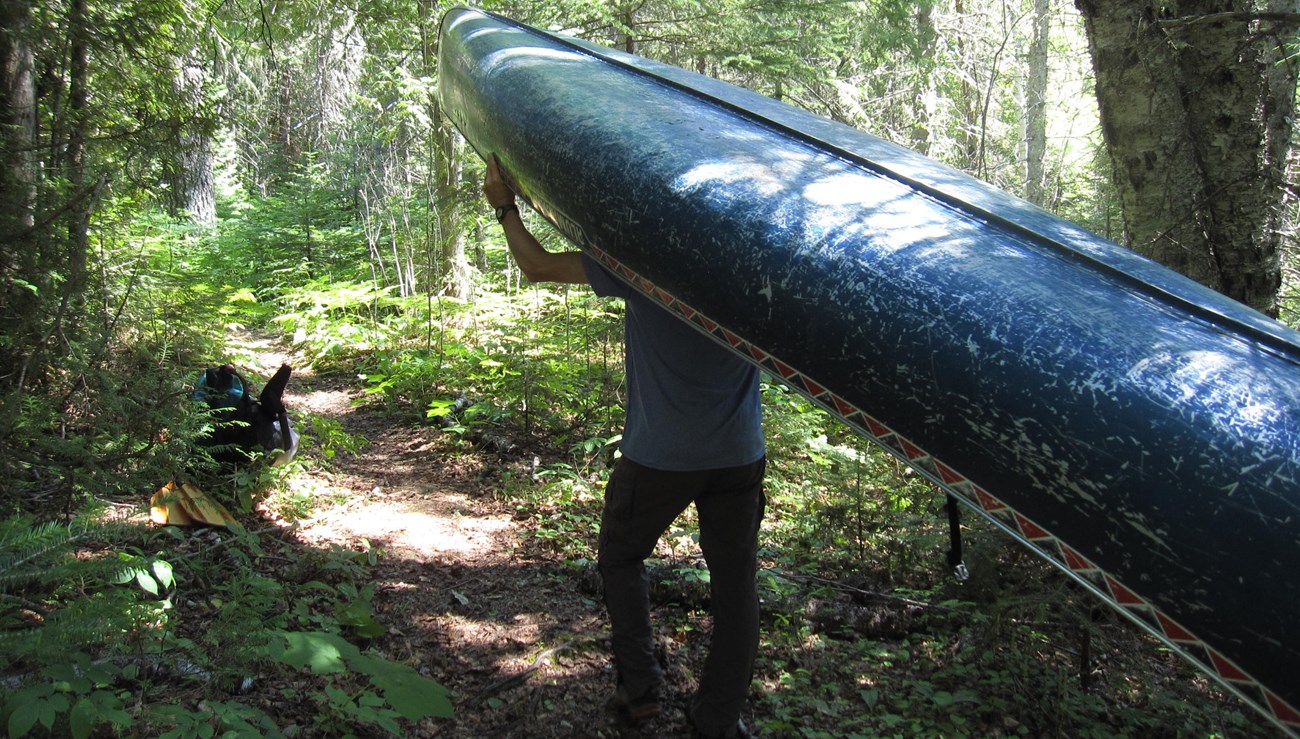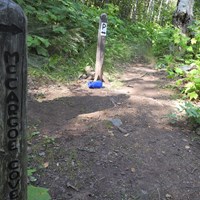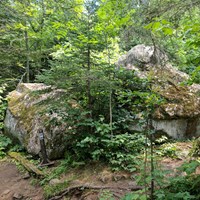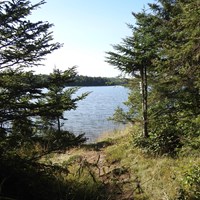
© Mike Ausema
About Portaging Interior Lakes
Rating: Intermediate paddlers
Duration: Multiple days
Essential Reading: Isle Royale's newspaper, The Greenstone
Recommended Vessel: Canoe
Wayfinding: Each portage is marked with a sign including the letter "P" to signify the portage trail.
- McCargoe Cove
- Chippewa Harbor
- Malone Bay
- Moskey Basin
A trip to Isle Royale requires advanced planning—including how you will get your vessel to the island. Some passenger ferries transport canoes and kayaks to Isle Royale. The National Park Service passenger ferry, Ranger III transports canoes, kayaks, and small boats. What ferry you choose depends on where you are traveling from and where you are aiming to explore.
Rock Harbor
Windigo
Getting to the Interior
It is possible to mix and match ferry transporation. You could bring a vessel on a ferry to an island transporation hub (Rock Harbor or Windigo) and utilize the Voyageur II to enter the island's interior. The Voyageur II transports kayaks and canoes to the following places:
- Windigo
- McCargoe Cove
- Belle Isle
- Rock Harbor
- Daisy Farm
- Chippewa Harbor
- Malone Bay
Portage from McCargoe Cove to Chippewa Harbor
Duration: 5 days
- Night 1: McCargoe Cove Campground
- Arrive on a Wednesday via Voyageur II passenger ferry and explore McCargoe Cove
- Arrive via water taxi from Rock Harbor Lodge
- Reservations are needed in advance
- Day hike to Minong Mine
- Night 2: West Chickenbone Campground
- Night 3: Lake Richie Canoe Campground
- Night 4: Chippewa Harbor Campground
- Depart via Voyageur II passenger ferry the next morning
Transportation
- Planning a trip to Isle Royale can feel complicated. Figuring out your transportation is the first step.
- Isle Royale is only accessible by seaplane, passenger ferry, or private boat. There are no roads or cars on Isle Royale.
Permits
-
Permits are required, regardless of group size or method of travel, for all overnight stays at campgrounds, cross country sites, docks, or at anchor.
-
Traveling with a group of 7 or more? You will need advanced reservations to camp. Learn more about group camping at Isle Royale.
Entrance fees
- There is no camping fee. There is a daily entrance fee of $7 per day. Plan ahead and pay your fees before your trip.
Invasive Species
- Do your part to diminish the spread of invasive species in the park by wiping down gear and vessels after it has contacted Lake Superior and before putting in at an interior lake.
Nesting Loons
- See a loon on land? Give it space. A nesting loon might not return if disturbed from its nest, which leaves loon chicks exposed to predators.
Help Isle Royale Stay Wild
- Isle Royale is isolated. Services are limited in the park. Be conservative and self-sufficient during your trip.
- Cell phone service is unreliable. Do not depend on it.
- A State of Michigan fishing license is required to fish Lake Superior; you do not need a license for interior lakes and streams.
- Check current conditions in the park before your trip.
- Stay hydrated.
- Watch the weather. Conditions deteriorate quickly and unexpectedly.
- Basic emergency services are available on the island, but response and evacuation take time. Self-reliance in the only immediate option in an emergency.
- Leave what you find. Removing, possessing, or disturbing park resources is prohibited.
- Pack it in, pack it out. All trash and leftover food must be packed out of the backcountry.
- Store food properly by securing in a hard sided, scent proof container, or doubled zip-lock bags.
- Campfires are permitted only at a handful of campgrounds. A backpacking stove is recommended.
- Respect wildlife. Observes from a safe distance. It is illegal to feed, touch, tease, or intentionally disturb wildlife, their homes, nests, or activities.
- Dogs, cats, and other mammals are not allowed, including pets on boats within park boundaries.
- Mosquitos and black flies peak in June or July and can continue into August. Wasps are common. Bring an epinephrine kit if allergic to stings.






